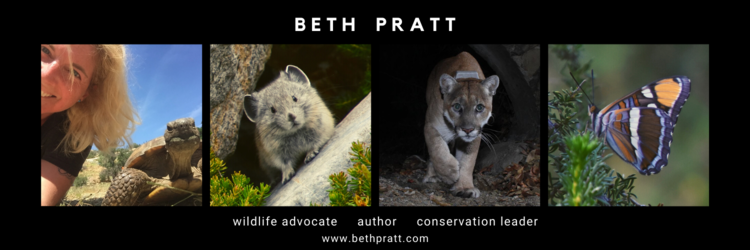California is a land of extremes, containing both the highest and lowest points in the continental United States, with a landscape in between of 100 million acres that boast a unique geologic history. This translates into an unparalled diversity of life. The Golden State is home to the highest number of both total species and endemic species—overall 2,500 animals and plants.
National Wildlife Week, March 19-25, this year features 45 extra-ordinary wildlife species and their amazing talents. To celebrate the extra-ordinary wildlife that live in the extra-ordinary state of California, here are some of the featured animals that call California home.
Wildlife with Innovative Defenses
Walking stick: The California walking stick subspecies has a wider body and shorter legs than its relatives. Aside from its camouflage, the walking stick employs a skunk-like defense mechanism: spraying foul smelling chemicals at their predators.
 Walking stick in my backyard (photo by Beth Pratt)
Walking stick in my backyard (photo by Beth Pratt)
California Toad: The ubiquitious California toad can be found from the coast to high mountains of the Sierra. He keeps predators away by producing a milky liquid in some of his warts that is both bad-tasting and poisonous.
 California toad in my frog pond (photo by Beth Pratt)
California toad in my frog pond (photo by Beth Pratt)
Wildlife that Survive in Unusual Habitats
Bighorn sheep: These intrepid animals live in some of the harshest environments in the state: the high elevations of the Sierra Nevada and the blazing heat of the Mojave Desert.
 Desert bighorn in Anza Borrego State Park (photo by Beth Pratt)
Desert bighorn in Anza Borrego State Park (photo by Beth Pratt)
Vernal pool fairy shrimp: These tiny creatures live in ephemeral vernal pools and have a short life span of about two months. After the pool dries up in the summer, eggs remain in the soil. When water returns to the vernal pool the next winter a new generation hatches.
Wildlife with Special Adaptations
 Long-jawed, org weaving spider in my backyard (photo by Beth Pratt)Garden spider: I spotted this long-jawed, orb-weaving spider on a plant in my frog pond. These artistic engineers of the spider world build spiral webs with beautiful patterns to catch their prey.
Long-jawed, org weaving spider in my backyard (photo by Beth Pratt)Garden spider: I spotted this long-jawed, orb-weaving spider on a plant in my frog pond. These artistic engineers of the spider world build spiral webs with beautiful patterns to catch their prey.
American Dipper: On contrast to his ordinary appearance, this unusual bird makes his home in mountain streams and hunts underwater—no easy task in swift running waters.
Wildlife that are Record Breakers
Blue whale: The magnificent blue whale is the largest living animal on earth. The marine mammal can stretch to lengths of over 100 feet—its head alone accounts for ¼ of its body length! On average the blue whale weighs 100-150 tons.
Pronghorn: As the fastest land mammal in North America, these fleet-footed creatures can sprint across a grassy steppe at speeds of up to 60 mph.; even a newborn fawn a couple of days after its birth can run faster than a human.
 Pronghorn running at full speed (photo by Beth Pratt)
Pronghorn running at full speed (photo by Beth Pratt)
 Great horned owl (photo by Beth Pratt)Wildlife with Super Senses
Great horned owl (photo by Beth Pratt)Wildlife with Super Senses
Rattlesnake: Rattlesnakes sense their prey through special heat-sensing organs located near their eyes. Rattlesnakes are California’s only native venomous snake and the state contains seven species.
Great horned owl: These owls are skilled hunters with a well-developed sense of hearing-they can hear the footsteps of a moose from 75 feet away!

